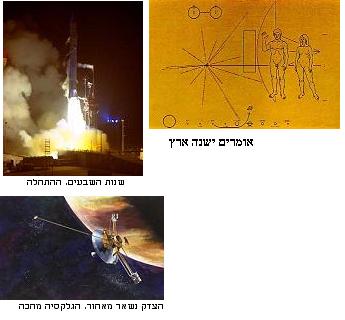The Pioneer 10 spacecraft is not behaving as its operators expect it to. For example, it is not where it is supposed to be in space. and a few more things. The article appeared on Ami Ben Best's blog "Ktza"

The truth is that Pioneer has long since finished its obligations to its operators, the scientists of the American space agency, NASA, and it even has quite a list of achievements. For example, Pioneer was the first to cross the asteroid belt - that dense belt of fragments of fragments and rocks that surrounds the Sun between Mars and Jupiter, and photographed Jupiter up close. Pioneer also proved that it is possible to successfully exploit the enormous gravitational force of the planet Jupiter, and use it, in order to change direction and get additional acceleration, which allows it to leave the limits of the solar system.
The dimension of imagination in this plot is contributed by a small aluminum plate, gold-plated, found in the spaceship and containing an astronomical map and a series of symbols and messages from the members of the human race. If a Pioneer is ever found by any intelligent civilization, it will be able to tell it by signs and symbols, the story of the species that sent it. The certainty as to the existence of such a meeting, it must be said, does not seem high, although Pioneer's galactic journey will continue for millions, perhaps billions of years, and the time for the meeting is abundant.
Pioneer provided the first surprise to its operators already in the first decade of its existence. The expectations of the spacecraft operators were that during 1979, when the spacecraft would be somewhere in the icy expanses of the planet Uranus, seven years after its launch, contact with it would be cut off. In practice, Pioneer was not silent. It continued to transmit data, far beyond Uranus, for the next twenty years, until the year 2000. The last electrical signal received from it was in February 2003, when it was a fantastic distance of over 11 billion km from its home planet.
A few years earlier, her first deviation was discovered. On December 8, 1992, when the spacecraft was in the region known as the "Kuiper Belt"*, it suddenly deviated from its course unexpectedly. Although the deviation was not large and the scientists believe that the culprit was the gravity of a large object, probably an asteroid, that Pioneer passed near. But this deviation was nothing compared to the anomaly discovered in recent years. A team of scientists following Pioneer 10 discovered that it is not where it should be, at least according to the theoretical data. The calculations of its trajectory (and that of the sister spaceship, Pioneer 11) show that there is "something", some force, that affects the spaceship and causes it not to move at the "correct" speed. The deviation is indeed tiny (a few centimeters per second), but it causes great uneasiness among astronomers. Scientists don't like anomalies, and as soon as a body behaves not according to the equations, they get stressed. The truth is that they have a good reason for this (and maybe us, the little citizens too), our earthly technology is based, most of it as a whole, on a series of regular laws and equations, and if one thing doesn't work according to the laws, other things can too.
As of today, no one knows what this mysterious force is that acts on Pioneer and there is a long line of explanations, starting with radiation pressures and gravitational disturbances of other objects, ending with gas leaks and the existence of a dark, invisible substance whose mass disrupts the movement of the spacecraft. Another hypothesis that is gaining momentum recently is that there is probably an unknown "effect" in general relativity that affects the speed of the spacecraft.
What happens now? If all goes well, and nothing slows Pioneer down or deviates from its course, this capricious spacecraft will completely escape the Sun's gravitational influence in about 126,000 years. Then Pioneer will "officially" begin her thrilling odyssey across the galaxy. In the next million years the spacecraft will pass around ten different stars, and then, everything is open! What is certain is that it will continue to move "somewhere", long after our good sun turns into a "red giant" and dies, and with it the world that sent Pioneer 10 on its way.
———–
* Belt of comets - large icy bodies moving around the Sun, far beyond the orbit of the planet Pluto.
